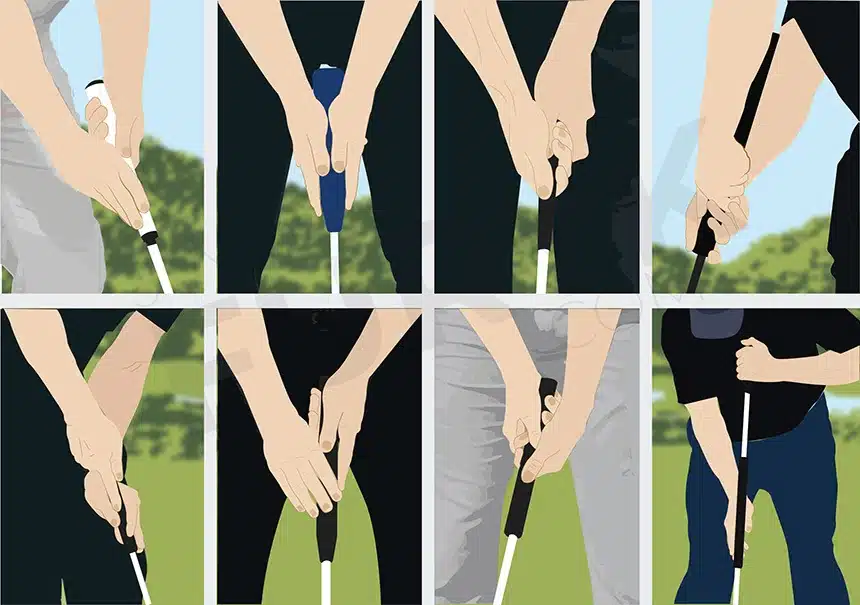When you can putt accurately, you have indeed acquired one of the most challenging golfing skills. Your putting grip and normal full-swing golf grip are not the same, they shouldn’t be the same either. Otherwise, your arms and hands will never be able to achieve any amount of consistency in your putting strokes.
So how to grip the putter correctly? There’s the conventional grip of course, but there are also more gripping styles that so many PGA-level players choose!
In This Post
- The Most Common Putting Grip Techniques In Golf
- Arm Lock Grip (used by 5.8% of golfers)
- What Is A Traditional Golf Grip?
- Which Putting Grip Is Right for You?
- Why Is Putting Grip So Important?
- What Size Putting Grip Is Best for You?
- Is Grip for Irons the Same for Putters?
- What Is Tiger Woods Putting Grip?
- Can You Regrip Your Putter?
- Conclusion
The Most Common Putting Grip Techniques In Golf
The following putting grips are the most famously spotted on the PGA Tour. So we’re looking at putting grips that big-league players have taken up to increase stroke consistency and drastically minimize the chances of missed putts.
Conventional or Reverse Overlap Grip (used by 68.5% of golfers)
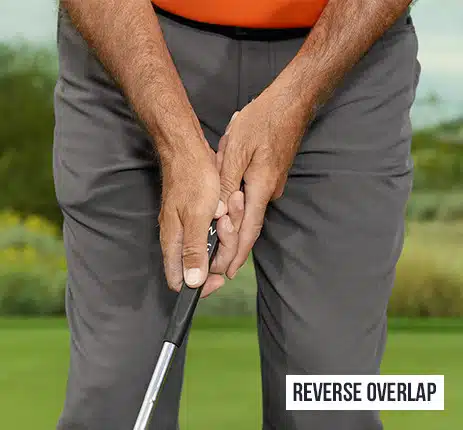
Who uses this grip – Tiger Woods, Jason Day, and Rory McIlroy
The reverse overlap or conventional grip, by far, is the most prevalent among pro-level golfers. Tiger Woods himself relies on this particular gripping method. Basically, it’s just another variation of the very popular overlap grip often accompanied by a full golf swing.
How it works is that you place the right hand in the bottom, and your thumb should be pointing straight down along the shaft. Then with the left hand, position the pinky, ring, and middle fingers around the shaft, meaning wrap the fingers around the back of the club shaft. Then place the index finger over the right-hand fingers holding your golf club.
Why players like Tiger Woods use this conventional grip for putting is because it allows locking in those hands. In that case, no need to deal with unwanted, excessive wrist hinge. No clubface rotation either when executing a flawless putting stroke.
You may also want to note that the conventional grip feels the most effortless since hands naturally become accustomed to gripping golf clubs.
Left Hand Low Grip (used by 12.9% of golfers)
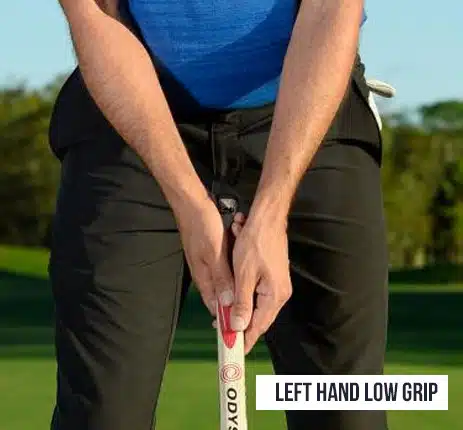
Who uses this grip – Dustin Johnson, Alex Noren, and Jordan Spieth
Also known as the cross-handed grip, the left hand low gripping technique consists of placing the left hand low indeed (right hand for lefties), lower than the other one. This positions your dominant hand the most favorably when it comes to powering the golf club without having to manipulate its clubface.
Putter grip ridge is placed in the left hand, and mindfully keep the wrist weak at this point where the back of that hand faces your target for minimizing any rotational movement in your joint. Now, instead of the left thumb that usually runs along the center, make sure it’s slightly more toward the shaft’s left side.
Then position the right hand over the left and form the same grip on the right hand as you did with your left one except that the right wrist should be strong.
Even Jack Nicklaus admits that he regrets not ever learning how to putt using the left-hand-low approach. After all, this particular gripping strategy is the very solution to common problems like overactive wrists and flipping the golf club with the hands.
In that case, when the left hand is placed lower, you’re automatically compelled to keep your right hand out of the picture as much as possible during your putting stroke. At such times, your left hand is locked into position, hence it leads your club during the backswing and follow-through. And this, in turn, translates into much easier path and speed control.
Arm Lock Grip (used by 5.8% of golfers)
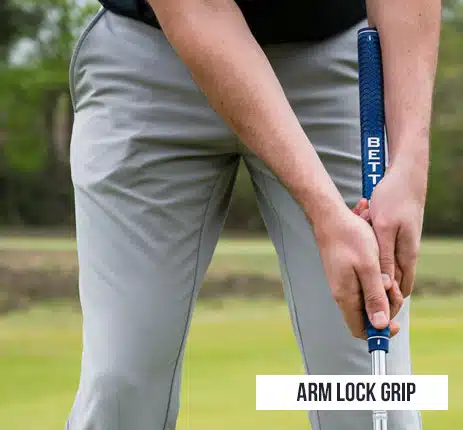
Who uses this grip – Keegan Bradley, Matt Kuchar, and Bryson DeChambeau
For this to work, you need to be using a longer-shafted putter (understanding putter length), which has proven to be the most effective in terms of boosting stability.
How the arm lock grip works is pretty much like the reverse overlap or conventional grip except for your left hand being in a relatively weaker position. As a result, the handle of the putter ends up running along the palm of your hand and pressing up against your left forearm.
In short, the putter and your arm move as a single unit, which is sure to create greater stability. At the same time, this makes it really difficult for the clubface to flip close or flare open during the strike. Just focus all your attention and energy on making your putter follow the smooth, seamless straight-back-straight-through line with the right pace.
The Claw Grip (used by 8.6% of golfers)
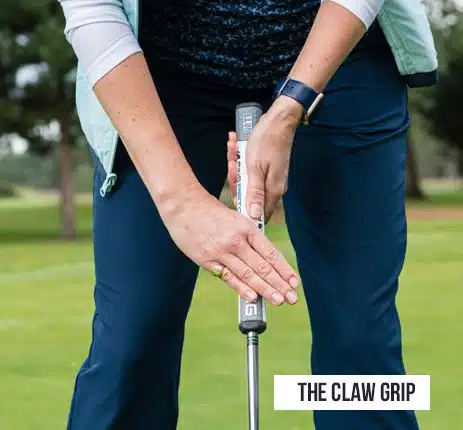
Who uses this grip – Tommy Fleetwood, Phil Mickelson, Justin Rose, and Tony Finau
Phil Mickelson is definitely doing something right with the claw grip, which we all saw during his PGA Championship win in 2021. It’s actually one of the most popular and most used putting grips on the PGA Tour.
Nothing like the conventional setting, claw grip requires you to grip your putter at the top using the left hand. You know you’re doing it the correct way when the thumb is running down along the center of that shaft.
Next, place the right hand below, so the handle is now running through the thumb and index finger crevice. And finish it off by pinching the handle gently.
The biggest advantage here is that the claw grip resolves concerns such as overactive wrists and hands and closing or flaring open the clubface at impact. The claw-like practice ensures limited movement of parts during the stroke to keep that clubface square.
Arm Lock with Claw Grip (used by 2.8% of golfers)
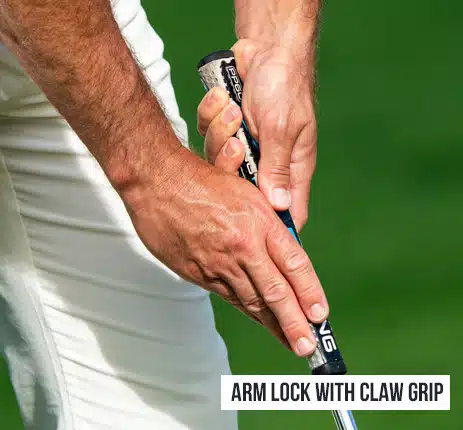
Who uses this grip – Webb Simpson
Combine the techniques of claw and arm lock for creating an extremely stable, rigid putting stroke. The arm lock with claw approach almost completely keeps your right hand off the stroke whilst allowing the left one (hand and arm) to perform the greater part of the movement. Thus, direction and speed maximized!
Grip your putter with the left hand just like in the arm-lock manner. The shaft is supposed to be pressed against the left forearms. Then add the right-hand index finger and thumb to the putter handle underneath the left hand, much the same as you would normally do with the claw gripping method.
This way, the putter behaves like an extended version of the left arm. Your right hand, as a result, plays almost no part in determining direction or speed. Rather it only helps for stabilizing the clubface.
Broomstick Grip (used by 1.4% of golfers)
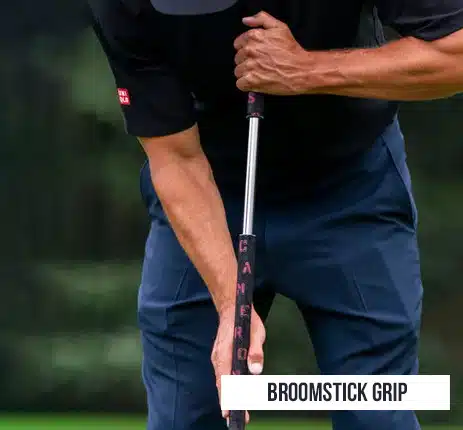
Who uses this grip – Bernhard Langer, Adam Scott
Comparatively speaking, it’s not the most popular on the PGA Tour simply because players now are not allowed to “anchor” their putter against the chest (known as the anchor ban).
The broomstick technique involves the left hand gently gripping the top using your fingertips instead of allowing the palm to accommodate the handle. As for the right hand, you either grip that handle in a way where the palm faces away or use the claw grip for keeping your right hand from being too dominant.
With this broomstick grip method, you actually engage your big shoulder and chest muscles. Meaning your hands, during the putting stroke, remain passive. And this is very helpful if you struggle with bending over or if standing tall to make the stroke is a preferable choice.
The Prayer Grip
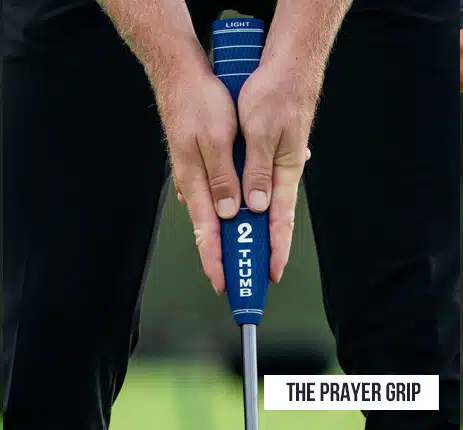
Who uses this grip – Paul Dunne and Matt Wallace
Just like left hand low (where you literally keep your left hand low), even the prayer grip requires you to grip your putter handle using prayer hands i.e. placed symmetrically on each side. Meaning both hands grip that handle in the same manner.
Just position the left palm and right palm on the left side and right side (of the putter handle) respectively. Make sure that the hands aren’t too closely placed toward the bottom or the top, rather they ought to be in the center.
Allow the index fingers to run down along the grip on either side. Do that or wrap them underneath. And lastly, during the putting stroke, keep in mind that maintaining the same distance between both your elbows is a must (both elbows should be bent slightly) throughout the whole backswing and into the follow-through.
You see Tour-grade players choose the prayer grip for the simple reason that it helps to generate a much smoother stroke where choking the golf club becomes impossible. All because you don’t end up gripping the club too tightly!
Also, both your hands are equally leveled instead of one being higher than the other. The outcome of which is symmetry and consistency in putting stroke.
Wrist Lock Grip
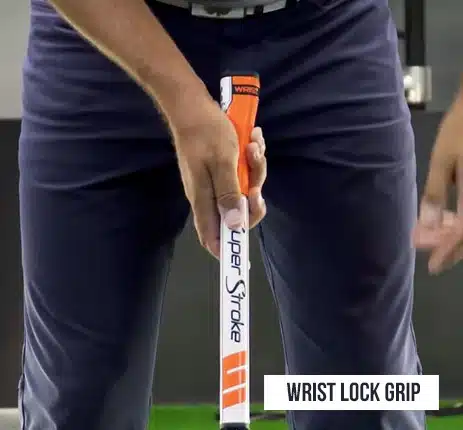
Who uses this grip – Bernhard Langer
Here’s the last of the most popular PGA Tour putting grips in the game of golf. You know, it’s got a lot in common with the arm lock grip except that wrist lock isn’t as dramatic.
You start by placing your left hand close to the bottom with your left forearm pressed up against the putter handle using your right hand. The influence of the right hand is reduced drastically, even more so than in the case of the claw grip. Even your left hand participation is comparatively more minimal.
Simply put, the wrist lock style paves the way for your shoulders and arms to take over and produce a steady, flawless pendulum-like putting stroke. So it’s worth a try if your hands tense up a lot or when overactive wrists tend to ruin your entire stroke.
What Is A Traditional Golf Grip?
Your dominant hand (left for right-handed golfers and right for lefties) should be positioned on the top with the trail hand directly underneath it.
The next step is to make sure your grip is running down along the palm and fingers of the leading hand, while the trail hand’s palm ought to sit right on top of that lead hand.
Which Putting Grip Is Right for You?
To be honest, you have to experiment with different gripping techniques. It’s the only effective way of determining which grip works the best for you and also feels the most comfortable. The ultimate goal is to be able to add direction and speed control to your putts on a consistent basis.
Why Is Putting Grip So Important?
If you plan on continuing with or adopting the grip of your full golf swing, you’re not doing it right when it comes to putting performance.
Full-swing grip works when you want to produce long-distance shots, hence it’s not the best for putting. The unwanted or excessive wrist action here leads to clubface rotation during the putting stroke. And this is how distance control and accuracy are compromised.
With the standard full-swing grip, the ball will start off the line. Even if this off-target start is disconnected by one degree, the golf ball either misses the hole or lips out. Therefore, you should prevent clubface rotation at all costs.
Transitioning to a proper or correct putting grip from your full-swing grip means re-orienting the grip. In the case of the latter, the grip is running diagonally across the fingers into the palms. As for the former, the grip needs to run up the “lifeline” crease of the palm of your dominant hand.
What Size Putting Grip Is Best for You?
As long as we’re talking about putter grip size, there’s no one “right” answer. Rather it all comes down to what you prefer.
On the one hand, you have thicker grips that eliminate overactive hands during the putting stroke. But if you find these thicker putter grips uncomfortable, then go for a thinner grip.
Experiment with different grip sizes, so you know what feels and works the best for your putting performance.
Is Grip for Irons the Same for Putters?
Gripping the putter in the same manner you grip your irons welcomes the possibility of a poor putting stroke and overall performance. You have to understand that it’s called a putting stroke and not a swing. Thus, a different style or method of gripping is essential.
What Is Tiger Woods Putting Grip?
Tiger Woods uses the conventional putting grip, also called the reverse overlap grip. You place your right hand underneath the left one, making sure that both hands are in a square or neutral position. The thumb should be positioned straight down along the center of the grip of the putter.
Can You Regrip Your Putter?
Regripping, no doubt, is a great way to reset things without having to spend a lot of money. What you need for the task is a new putter grip, grip tape, grip solution, and grip removal tool. It’s not a very tough job in case you’re wondering! Here are the step-by-step instructions and tips to regrip your golf clubs.
Conclusion
Why overlook the putting grip when you’re so careful about other factors like alignment, the position of the golf ball, etc.! Even when one part of the process is flawed, working on the others is not going to matter all that much. And how can you not bother about the grip? After all, it’s the only point of contact between you and your club!
However, there’s no one right approach to putting grip, you have to try out the many different techniques in order to find one that feels comfortable and provides your putting performance with that much-needed boost.
Just keep in mind that the final goal of any putting grip is to allow you to produce a more efficient, smoother putting stroke where your wrists and hands aren’t overactive or over-involved. Only then does consistency become a part of the whole process!

